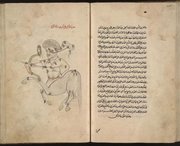Abd Al-Rahman Al Sufi
|
|
'Abd Al-Rahman Al Sufi (December 7, 903 – May 25, 986) was a Persian astronomer also known as 'Abd ar-Rahman as-Sufi, or 'Abd al-Rahman Abu al-Husain, and known in the west as Azophi.
He lived at the court of Emir Adud ad-Daula in Isfahan, Persia, and worked on translating and expanding Greek astronomical works, especially the Almagest of Ptolemy. He contributed several corrections to Ptolemy's star list and did his own brightness and magnitude estimates which frequently deviated from those in Ptolemy's work. He identified the Large Magellanic Cloud, which is visible from Yemen, though not from Isfahan; it was not seen by Europeans until magellan's voyage in the 16th century.
He was a major translator into Arabic of the Hellenistic astronomy that had been centred in Alexandria, the first to attempt to relate the Greek with the traditional Arabic star names and constellations, which were completely unrelated and overlapped in complicated ways.
He observed that the ecliptic plane is inclined with respect to the celestial equator and more accurately calculated the length of the tropical year. He observed and described the stars, their positions, their magnitudes and their colour, setting out his results constellation by constellation. He identified the Large Magellanic Cloud, visible from Yemen, though not from Isfahan. For each constellation, he provided two drawings, one from the outside of a celestial globe, and the other from the inside (as seen from the earth). Al Sufi also wrote about the astrolabe, finding numerous additional uses for it.
Al Sufi published his famous "Book of Fixed Stars" in 964, describing much of his work, both in textual descriptions and pictures.
Azophi crater on the Moon is named after him.
External links
- Biography of Al Sufi (http://www.seds.org/messier/xtra/Bios/alsufi.html)
- A page about Muslim Astronomers (http://www.muslimheritage.com/topics/default.cfm?ArticleID=232)

